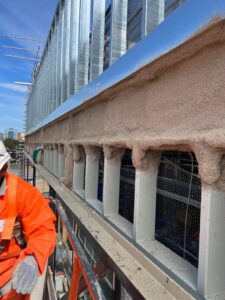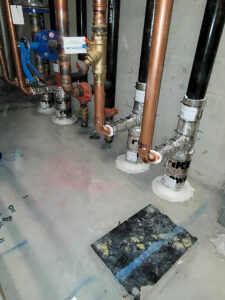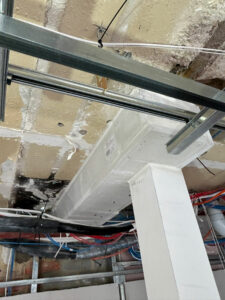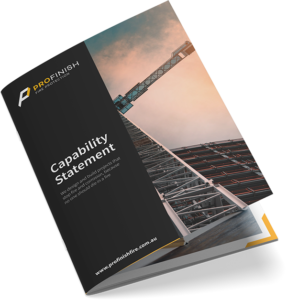In the world of fire safety, passive fire protection plays a crucial role in preventing the spread of fire, protecting lives, and minimising property damage. A key component of effective passive fire protection is the application of specialised fire-resistant products. In this blog post, we’ll explore a range of essential passive fire products. These include Intumescent Paint, Vermiculite Fire Spray, Fire Stopping Penetrations, Fire Retardant Board, Speedpanel®, and Fire Rated Ductwork wrap. Let’s delve into each product and discover the significance of each one in ensuring robust fire safety measures in buildings.
Intumescent Paint: enhancing fire resistance
Intumescent paint is a remarkable passive fire protection product that offers enhanced fire resistance by forming a protective coating on surfaces. This specialised paint contains fire-retardant properties that activate when exposed to high temperatures, causing it to expand and create a thick layer of insulating char. The char acts as a shield, significantly slowing the spread of fire and providing valuable time for evacuation and firefighting efforts.
The application of intumescent paint is an effective method to enhance the fire resistance of various building materials, including structural steel, wood, and concrete. By applying this paint to surfaces, building materials become fortified with an additional layer of fire protection. This is particularly crucial in buildings such as commercial complexes, residential high-rises, and industrial facilities where fire safety is of utmost importance.
The versatility of intumescent paint means that it’s used in a range of applications. Not only does it provide fire protection when it’s applied to structural elements, but it also provides an aesthetic appeal. Intumescent paint can be applied to doors, walls, and ceilings, ensuring that fire doesn’t breach critical barriers of buildings.
Intumescent Paint – a thermal barrier and insulation
Intumescent paint can act as a thermal barrier, reducing heat transfer and enhancing energy efficiency within a building. Additionally, some variants of intumescent paint offer acoustic insulation properties, reducing noise transmission and improving overall acoustic comfort.
Intumescent Paint – enhancing building aesthetic
Intumescent paint provides passive fire protection without compromising the architectural design of a building. Unlike traditional fireproofing methods, such as encasing structural elements in concrete, intumescent paint allows for a more visually appealing finish. This makes it an ideal choice for buildings where aesthetics are as important as fire safety, such as historic structures, museums, and luxury residences.
Maintaining Intumescent Paint
Regular inspections and maintenance of intumescent paint are vital to its ongoing effectiveness. Periodic checks are required to be carried out. This ensures that the paint remains intact and free from any cracks, peeling, or damage. Any necessary repairs or touch-ups should be promptly addressed to maintain the paint’s fire protection capabilities.
Vermiculite Fire Spray: Forming an Effective Fire Barrier
 Vermiculite Fire Spray is a passive fire protection product playing a central role in creating effective fire barriers in buildings. This spray-on material is composed of vermiculite. Vermiculite is a natural mineral that expands when exposed to high temperatures. The expansion of vermiculite creates a thick and insulating layer that acts as a formidable barrier against fire.
Vermiculite Fire Spray is a passive fire protection product playing a central role in creating effective fire barriers in buildings. This spray-on material is composed of vermiculite. Vermiculite is a natural mineral that expands when exposed to high temperatures. The expansion of vermiculite creates a thick and insulating layer that acts as a formidable barrier against fire.
When applied to surfaces, Vermiculite Fire Spray forms a protective coating that effectively insulates and shields the underlying structure from the intense heat of a fire. It acts as a powerful fire-resistant barrier, preventing flames from rapidly spreading and providing crucial time for building occupants to evacuate safely.
Vermiculite Fire Spray is applied to various building elements, including structural steel, concrete and wood. Its ability to conform to irregular surfaces and adhere strongly to substrates makes it a highly adaptable solution for different construction scenarios.
Vermiculite Fire Spray – a thermal barrier and insulation
In addition to its fire resistance properties, Vermiculite Fire Spray also offers other valuable benefits. It acts as an acoustic insulator, reducing noise transmission between spaces and improving overall acoustic comfort. Furthermore, it provides thermal insulation, helping to regulate temperature and energy efficiency within a building.
When considering the selection of Vermiculite Fire Spray, it’s important to engage the expertise of fire protection professionals. They possess the knowledge and experience to assess the specific fire safety requirements of a building and determine the appropriate thickness and application method for the vermiculite spray. This ensures that the desired fire resistance rating is achieved. Also, the application is carried out in compliance with relevant regulations and standards.
Fire Stopping Penetrations: Controlling Fire Pathways
 Ensuring effective fire-stopping in penetrations is critical to contain the spread of fire and smoke through walls, floors, and ceilings. Fire Stopping Penetrations are designed to seal gaps created by pipes, cables, and ducts, preventing fire from spreading between compartments. Using fire-resistant materials such as fire-rated sealants, collars, and wraps, ensures that these penetrations are effectively sealed. Engaging a fire protection professional to install and maintain fire-stopping penetrations is crucial to ensure compliance with fire safety regulations and maintain the effectiveness of the fire protection system.
Ensuring effective fire-stopping in penetrations is critical to contain the spread of fire and smoke through walls, floors, and ceilings. Fire Stopping Penetrations are designed to seal gaps created by pipes, cables, and ducts, preventing fire from spreading between compartments. Using fire-resistant materials such as fire-rated sealants, collars, and wraps, ensures that these penetrations are effectively sealed. Engaging a fire protection professional to install and maintain fire-stopping penetrations is crucial to ensure compliance with fire safety regulations and maintain the effectiveness of the fire protection system.
Some of the specific products commonly used for fire-stopping penetrations include:
- Fire-rated sealants: These are applied around penetrations, such as pipes, cables, or ducts, to create a fire barrier. They expand when exposed to high temperatures, forming a tight seal that inhibits the passage of fire and smoke.
- Firestop collars: Collar-like devices that encircle penetrations, such as pipes or ducts. They’re usually made of fire-resistant materials and help maintain the integrity of fire-rated walls or floors by preventing the spread of fire and hot gases.
- Firestop pillows: Soft, compressible pillows made of fire-resistant materials. They’re placed within larger openings or gaps, such as cable trays or electrical conduit penetrations, and expand when exposed to fire, effectively sealing off the passage of flames and smoke.
- Firestop putty: A pliable, dough-like material that can be easily moulded and applied around penetrations. It hardens when exposed to high temperatures, forming a fire-resistant barrier. Firestop putty is commonly used to seal small gaps or irregularly shaped openings.
- Firestop mortar: A cement material used to fill larger openings or voids around penetrations. It’s applied in a wet form and hardens into a solid, fire-resistant barrier. Firestop mortar is often used in conjunction with other fire-stopping products for added protection.
- Firestop boards: Rigid panels made of fire-resistant materials, such as mineral wool or cement boards. They’re used to cover larger openings or gaps and provide a high level of fire resistance.
- Firestop wraps and collars: Designed for sealing around fire-rated ductwork or pipes that pass through fire-rated walls or floors. They consist of fire-resistant materials that wrap around the ductwork or pipe, creating a seal that prevents fire and smoke from spreading.
These fire-stopping products are carefully selected and installed based on the specific requirements of the building and the type of penetration that’s being sealed. It’s important to engage fire protection professionals who have the expertise to assess the penetration types, fire resistance ratings, and applicable building codes to ensure the proper selection and installation of these products.
Fire Retardant Board: Strengthening Fire Resistance
 Fire retardant boards are a crucial component of passive fire protection systems, providing robust fire resistance to walls, ceilings, and other structural elements. Fire retardant boards are made from inherently fire-resistant materials such as gypsum, cementitious compounds, or mineral wool. They undergo specific manufacturing processes that enhance their fire-resistant properties, ensuring they meet stringent fire safety standards and regulations.
Fire retardant boards are a crucial component of passive fire protection systems, providing robust fire resistance to walls, ceilings, and other structural elements. Fire retardant boards are made from inherently fire-resistant materials such as gypsum, cementitious compounds, or mineral wool. They undergo specific manufacturing processes that enhance their fire-resistant properties, ensuring they meet stringent fire safety standards and regulations.
One of the primary applications of fire retardant boards is in constructing fire-rated walls and partitions. These boards are installed as an additional layer on the interior side of walls, enhancing their fire resistance and preventing the rapid spread of flames. Fire retardant boards act as a barrier, limiting the transfer of heat and protecting the structural integrity of a building.
Ceilings are another critical area where fire retardant boards are often used. By installing these boards as a suspended ceiling system, the fire resistance of the ceiling is significantly enhanced. Fire retardant boards act as a shield, preventing fire from spreading to the floors above and giving occupants more time to escape safely.
The installation of fire retardant boards requires careful consideration and adherence to fire safety standards. Fire protection professionals need to be engaged. They have expertise in selecting the appropriate type, thickness, and installation methods for fire retardant boards. An assessment needs to be made based on the specific requirements of the building and local regulations.
Speedpanel®: A Revolutionary Fire-Rated Building System
Speedpanel® is an innovative fire-rated building system that offers exceptional fire resistance and rapid installation capabilities. This lightweight and high-performance panel system comprises pre-finished steel sheets with a fire-resistant core. Speedpanel® can be used for walls, ceilings, and floors, providing a complete fire-rated solution. Its unique design enables quick assembly, reducing construction time and costs. With its outstanding fire resistance properties, Speedpanel® offers enhanced safety in buildings, ensuring that occupants have ample time to evacuate in the event of a fire.
Fire-Rated Ductwork Wrap: Safeguarding Ventilation Systems
Building ventilation systems consist of ductwork that can act as pathways for fire and smoke. Fire Rated Ductwork Wrap enhances the fire resistance of these ducts. By wrapping the ducts with fire-resistant materials, such as mineral wool or intumescent wraps, the spread of fire is effectively contained within the ductwork. This helps to protect the integrity of fire-rated compartments and ensures that smoke and toxic gases do not travel throughout the ventilation systems and the building. Fire Rated Ductwork Wrap is an essential component of fire safety in heating ventilation and air conditioning systems. It contributes to the overall fire protection measures in place.
Choosing the right passive fire products
These products help buildings meet fire safety regulations and standards, ensuring compliance and reducing liability risks. By investing in passive fire products, building owners and developers demonstrate their commitment to the safety and well-being of occupants. Incorporating multiple passive fire products into building designs and construction projects significantly enhances fire safety. Delaying the spread of fire allows occupants to evacuate and firefighters to control the situation. Passive fire products play a crucial role in enhancing fire safety in buildings, creating robust fire protection systems that safeguard lives and property.
Involve fire protection professionals
Involve fire protection professionals early in your project timeline. During the planning and design phase of projects, potential fire safety risks can be identified and addressed early. At PROFINISH we’ve worked on multiple projects using a combination of passive fire products such as Victoria Place, Geelong Arts Centre Redevelopment and COGG Civic Precinct. Call us on (03) 5274 1226 or email estimating@profinishfire.com.au to discuss your project and passive fire protection requirements.

